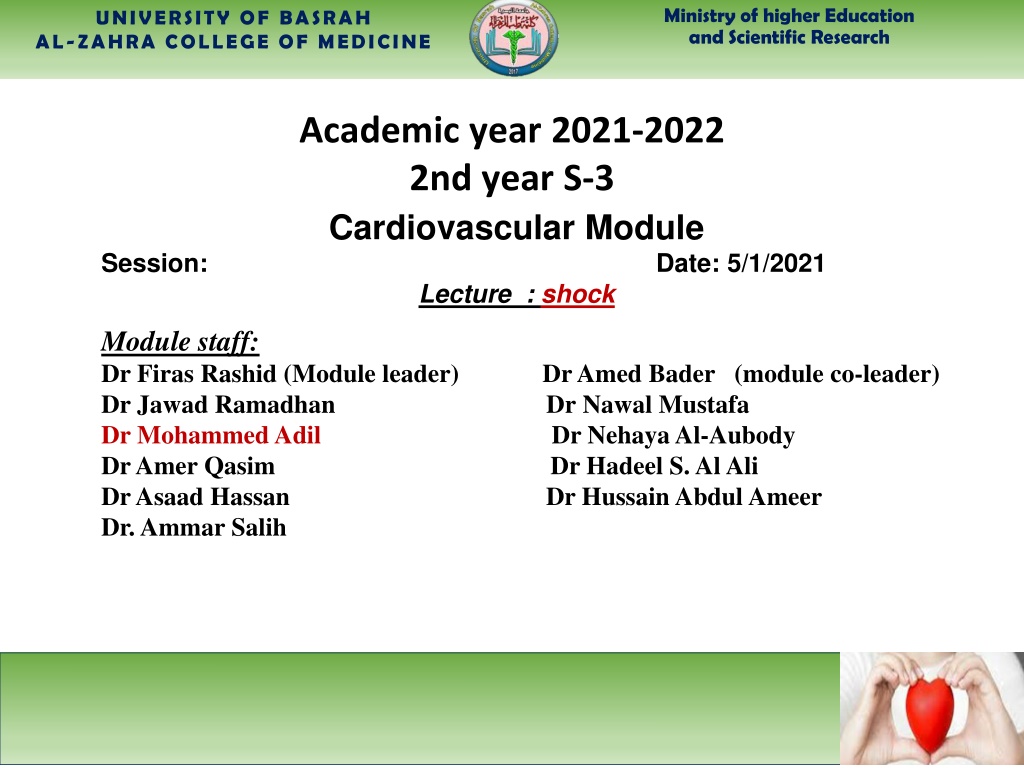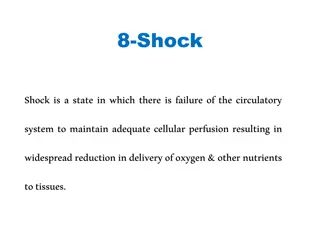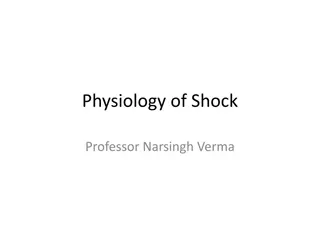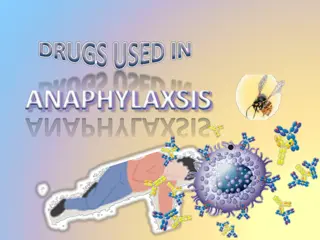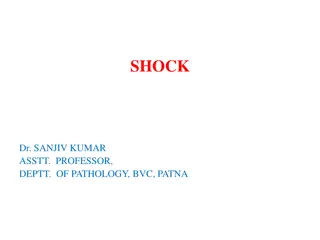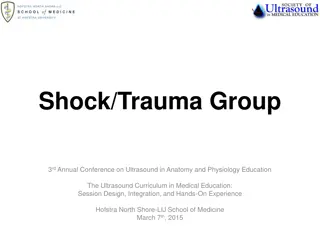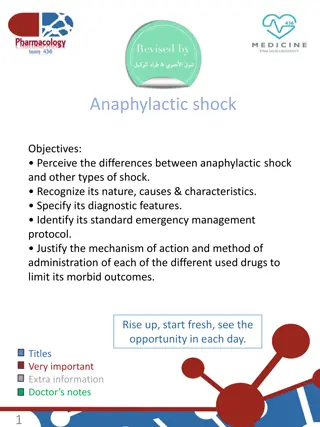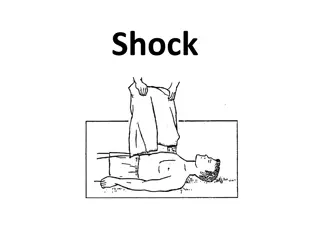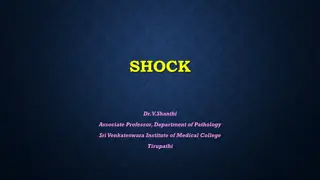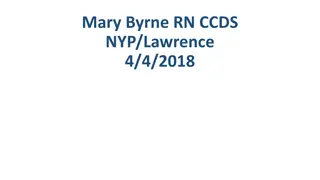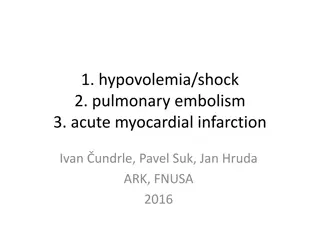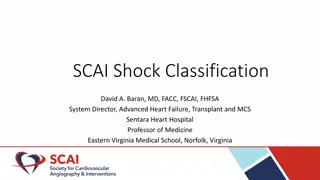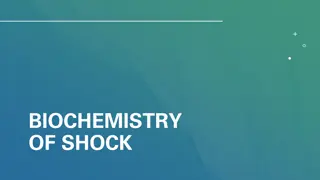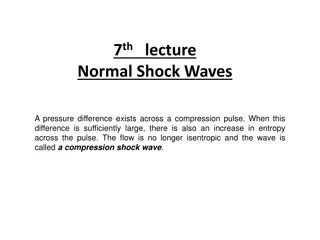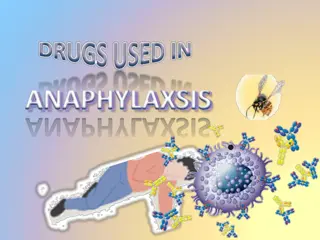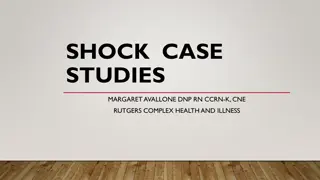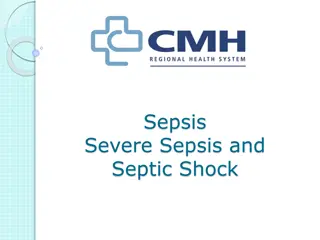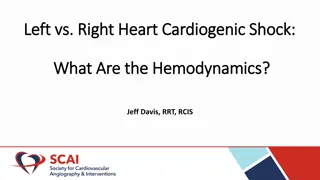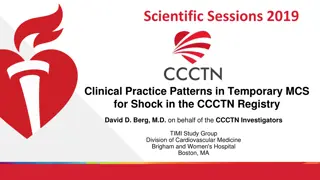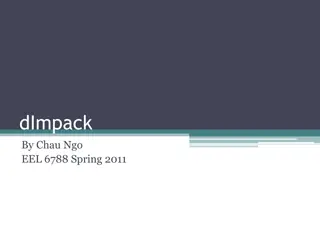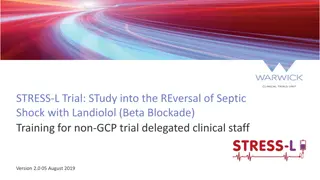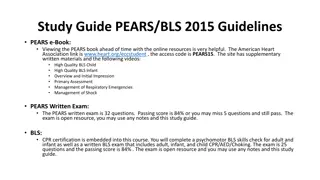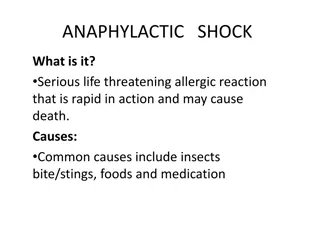Understanding Shock in Medical Science: Definitions, Classification, and Management
Shock is a critical condition caused by poor tissue perfusion leading to impaired cellular metabolism. This article discusses the definition of shock, its classification including septic, anaphylactic, cardiogenic, hypovolemic, and neurogenic shock, along with the clinical manifestations and hemodynamic changes. The management strategies for shock are also outlined to provide a comprehensive understanding for medical professionals and students.
Download Presentation

Please find below an Image/Link to download the presentation.
The content on the website is provided AS IS for your information and personal use only. It may not be sold, licensed, or shared on other websites without obtaining consent from the author. Download presentation by click this link. If you encounter any issues during the download, it is possible that the publisher has removed the file from their server.
E N D
Presentation Transcript
Ministry of higher Education and Scientific Research UNIVERSITY OF BASRAH AL-ZAHRA COLLEGE OF MEDICINE Academic year 2021-2022 2nd year S-3 Cardiovascular Module Session: Date: 5/1/2021 Lecture : shock Module staff: Dr Firas Rashid (Module leader) Dr Jawad Ramadhan Dr Nawal Mustafa Dr Mohammed AdilDr Nehaya Al-Aubody Dr Amer Qasim Dr Hadeel S. Al Ali Dr Asaad Hassan Dr Hussain Abdul Ameer Dr. Ammar Salih Dr Amed Bader (module co-leader)
Ministry of higher Education and Scientific Research UNIVERSITY OF BASRAH AL-ZAHRA COLLEGE OF MEDICINE Learning Outcomes By the end of lecture we should be able to: 1- define shock 2- classify shock according to stage and cause 3- know the clinical manifestation of shock 4- haemodynamic parameter changes in shock 5- Brief outline in management of shock
Ministry of higher Education and Scientific Research UNIVERSITY OF BASRAH AL-ZAHRA COLLEGE OF MEDICINE Shock definition: Shock is a life threating situation due to poor tissue perfusion with impaired cellular metabolism , manifested in turn by serious pathophysiological abnormalities (Baily and love). Shock is a term used to describe the clinical syndrome that develops when there is critical impairment of tissue perfusion due to some form of acute circulatory failure (Davidson). Shock maybe defined as inadequate delivery of oxygen and nutrients to maintain normal tissue and cellular function (Schwartz s).
Ministry of higher Education and Scientific Research UNIVERSITY OF BASRAH AL-ZAHRA COLLEGE OF MEDICINE Classification of shock: Septicshock(distributive): results from bacteria multiplying in the blood and releasing toxins. Common causes of this are pneumonia, urinary tract infections. Anaphylactic shock(distributive) is a type of severe hypersensitivity or allergic reaction. Causes include allergy to insect stings, medicines, or foods Cardiogenic shock happens when the heart is damaged and unable to supply sufficient blood to the body. This can be the end result of a heart attack or congestive heart failure.
Ministry of higher Education and Scientific Research UNIVERSITY OF BASRAH AL-ZAHRA COLLEGE OF MEDICINE Hypovolemic shock is caused by severe blood and fluid loss, such as from traumatic bodily injury, which makes the heart unable to pump enough blood to the body. Neurogenic shock is caused by spinal cord injury, usually as a result of a traumatic accident or injury.
Ministry of higher Education and Scientific Research UNIVERSITY OF BASRAH AL-ZAHRA COLLEGE OF MEDICINE Pathology of shock:
Ministry of higher Education and Scientific Research UNIVERSITY OF BASRAH AL-ZAHRA COLLEGE OF MEDICINE Effective circulatory blood volume Venous return to the heart Cardiac output Blood flow Supply of oxygen Anoxia Shock Hypovolemic shock Septic shock Anaphlactic shock Cardiogenic shock
Ministry of higher Education and Scientific Research UNIVERSITY OF BASRAH AL-ZAHRA COLLEGE OF MEDICINE Stages of shock: Deterioration of circulation in shock is a progressive and continuous phenomenon and compensatory mechanism become less effective. Non progressive (initial, compensated , reversible) shock Progressive decompensated shock Irreversible shock
Ministry of higher Education and Scientific Research UNIVERSITY OF BASRAH AL-ZAHRA COLLEGE OF MEDICINE Stages of shock:
Ministry of higher Education and Scientific Research UNIVERSITY OF BASRAH AL-ZAHRA COLLEGE OF MEDICINE Haemodynamic parameter in different type of shock Shock types PAR CO SVR preload cardiogenic Distributive cause Hypovolemic
Ministry of higher Education and Scientific Research UNIVERSITY OF BASRAH AL-ZAHRA COLLEGE OF MEDICINE Symptoms and sign of shock: Dizziness Lethargy Cold extremities Syncope Feature of underlying disease process Hypotension Tachycardia Rapid shallow respiration Decrease urine output MOF
Ministry of higher Education and Scientific Research UNIVERSITY OF BASRAH AL-ZAHRA COLLEGE OF MEDICINE
Ministry of higher Education and Scientific Research UNIVERSITY OF BASRAH AL-ZAHRA COLLEGE OF MEDICINE Management : Objective Increase cardiac output Increase tissue perfusion The plan of action should be based on : Primary problem Adequate fluid replacement Improving myocardial contractility Correction acid base disturbances
Ministry of higher Education and Scientific Research UNIVERSITY OF BASRAH AL-ZAHRA COLLEGE OF MEDICINE Haemorrhage Control bleeding (compression, tourniquet, surgical haemostasis). Determine blood group. Priority: restore vascular volume as quickly as possible Insert 2 peripheral IV lines (2 catheters 16G in adults). Ringer lactate or 0.9% sodium chloride: replace 3 times the estimated losses and/or plasma substitute: replace 1.5 times the estimated losses. Transfuse: classically once estimated blood loss represents approximately 30 to 40% of blood volume (25% in children).
Ministry of higher Education and Scientific Research UNIVERSITY OF BASRAH AL-ZAHRA COLLEGE OF MEDICINE Severe anaphylactic reaction Determine the causal agent and remove it. Administer epinephrine (adrenaline) IM, into the anterolateral part of the thigh, in the event of hypotension, pharyngolaryngeal oedema, or breathing difficulties Administer rapidly Ringer lactate or 0.9% sodium chloride.
Ministry of higher Education and Scientific Research UNIVERSITY OF BASRAH AL-ZAHRA COLLEGE OF MEDICINE Septic shock: Vascular fluid replacement with Ringer lactate or 0.9% sodium chloride or plasma substitute. Use of vasoconstrictors:( dopamine ,epinephrine) Look for the origin of the infection and administer antibiotic therapy according to the origin of infection.
Ministry of higher Education and Scientific Research UNIVERSITY OF BASRAH AL-ZAHRA COLLEGE OF MEDICINE Cardiogenic shock The objective is to restore efficient cardiac output. The treatment of cardiogenic shock depends on its mechanism. Acute left heart failure with pulmonary oedema Cardiac tamponade: restricted cardiac filling as a result of haemopericardium or pericarditis.requires immediate pericardial tap after restoration of circulating volume. Tension pneumothorax: drainage of the pneumothorax. Symptomatic pulmonary embolism: treat with an anticoagulant in a hospital setting.
Ministry of higher Education and Scientific Research UNIVERSITY OF BASRAH AL-ZAHRA COLLEGE OF MEDICINE References: 1- Davidson 23rd ed. Text book of internal medicine 2- MKSAP 2018
Ministry of higher Education and Scientific Research UNIVERSITY OF BASRAH AL-ZAHRA COLLEGE OF MEDICINE Thank you
